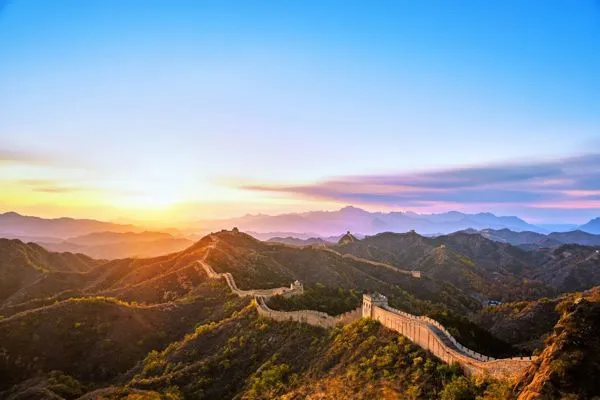Why is the performance of Chinese civilization so "unparalleled" that it is also subject to collisions, impacts, and even aggression and oppression?
In the long course of development of human society, many ancient civilizations with their own characteristics have been born in various parts of the world. Today, many ancient civilizations that have had a profound impact on human history have disappeared. In comparison, the Chinese civilization has been tempered by wind and frost for more than 5,000 years. It has not only continued in the same vein without interruption, but has also been further rejuvenated. The resilience, patience, and determination of Chinese civilization are the key to the inheritance of China's excellent traditional culture from generation to generation and the endless prosperity of the Chinese nation.
The origin and development of any civilization is not smooth sailing, and will inevitably be affected by both natural conditions and human factors. Whether we can successfully meet these challenges is the key to determining the rise and fall of civilization.
In the face of various crises and challenges, Chinese civilization has shown unique historical resilience, turning crises into vitality, and endowed the Chinese nation with strong self-healing capabilities for the continuation and development of the nation.
From ancient times to the present, the continuation and development of human civilization has always been threatened by natural disasters. Compared with other civilized regions in the world, China's natural endowments are not outstanding, and various natural disasters occur frequently.
Preliminary statistics show that in the more than 3,700 years from 1766 BC to 1937 AD, China experienced a total of 5,258 major disasters such as floods, droughts, locusts, hail, winds, epidemics, earthquakes, frosts, and snows. There are almost no disasters, and there is almost no famine year after year.”
In the face of frequent natural disasters, the Chinese nation actively responds to challenges and shows its tenacity.
In ancient times, floods flooded the Central Plains, and "the people were at a loss. Those below were nests, and those above were camps." The people were displaced and could not live in peace. Under the leadership of Dayu, the Chinese ancestors "digged the ground and poured it into the sea" to dredge waterways with their hands and feet covered. Dayu himself was even more "poor in food and clothing" and "in a humble palace". He lived outside for more than ten years and never entered his house three times.
With the joint efforts of the Chinese ancestors, the flood was finally tamed, and "people had to live on the flat land" and "China could get food and eat". People's lives returned to normal track, and the Chinese civilization survived the catastrophe and was reborn in Nirvana.
Archaeological discoveries have also confirmed that in the lower reaches of the Yangtze River, where floods are frequent, the Liangzhu ancestors built relatively developed dams, artificial lakes, and artificial rivers. While trying to reduce flood disasters that endanger production and life, they further developed advanced rice farming. culture.
The Yellow River is the "mother river" of the Chinese nation. The early prototypes of Chinese civilization such as Peiligang Culture, Yangshao Culture, Longshan Culture, and Dawenkou Culture are distributed in this river basin. However, due to the influence of special geological conditions and climatic factors, the river channels in the lower reaches of the Yellow River are extremely prone to siltation and frequent overflows.
According to statistics, in more than 2,500 years from 602 BC to 1938 AD, the Yellow River burst more than 1,590 times and changed its course twenty or thirty times. Through the continuous efforts of Bai Gui of the Warring States Period, Wang Jing of the Eastern Han Dynasty, Gao Chao of the Northern Song Dynasty, Jia Lu of the Yuan Dynasty, Pan Jixun of the Ming Dynasty and others, they finally found a more effective strategy to control the Yellow River: "Building embankments to contain water and using water to attack sand".
The tenacity of successive dynasties to control floods in the Yellow River allowed the Yellow River Basin, as the core area of Chinese civilization, to quickly recover from the damage of disasters time and time again. It became the center of China's politics, economy, and culture before the Song Dynasty, and preserved the root and soul of Chinese civilization.
Chinese civilization does not maintain historical continuity in static and stagnant conditions, but achieves the continuity of civilization through constant change and renewal. During this process, the Chinese nation has maintained a considerable degree of historical patience and is clearly aware that "haste leads to waste, and sudden advance only leads to destruction." It has put the system that is related to the destiny of the country and nation into the broad perspective of history. Take care of it. While following the laws of history, we must grasp the historical initiative so that the innovation of Chinese civilization can be steady and far-reaching and achieve long-term success.
Maintaining historical patience has enabled China to explore a local governance system that can not only effectively govern its vast territory, but also gradually complete regional integration. Compared with the feudal system of Xia, Shang and Zhou dynasties, which was mainly characterized by decentralization, the county system characterized by vertical management created during the Spring and Autumn Period and the Warring States Period was conducive to the strengthening of centralization and the consolidation and unification of the country, and gradually became the local administrative system of China after the Qin and Han Dynasties. mainstream of the system.
While the central governments of past dynasties vigorously maintained and improved the system of counties and counties, they did not adopt a one-size-fits-all approach, but fully considered the cost of governance and the characteristics of border minority areas and "governed according to customs": the system of restraints was implemented in the Tang and Song dynasties, and the system was implemented in the Yuan and Ming dynasties. In addition to inheriting the chieftain system, the Qing Dynasty also created the alliance flag and berk system to manage the northwest region...
Traditional China was very cautious about incorporating areas under special administrative jurisdiction into the county system. The "return to local rule" in the southwest began in the Yongle period of the Ming Dynasty, and accelerated after the Kangxi period of the Qing Dynasty. It took hundreds of years before the vast areas where native officials were hereditary were changed into prefectures and counties under the jurisdiction of floating officials.
Maintaining historical patience in this way not only fully takes into account the economic, cultural and religious backgrounds of different regions, safeguards the unity and consolidation of the country on the basis of respecting differences, but also steadily promotes exchanges and integration among various regions and ethnic groups, and promotes inter-regional integration and integration. The Chinese nation community was formed and consolidated.
Maintaining historical patience enabled China's reform of the tax system to be consistent with the level of productivity at that time, and maintained the overall stability of the country's financial economy. Research shows that the monetization of taxes, especially the silverization of taxes, can reduce the personal constraints of the feudal regime on farmers and promote the development of the commodity economy, which is progressive.
Taking into account the currency circulation situation and the state's control capabilities, various dynasties generally limited currency collection within a certain range. Even the "One Whip Law", which had a far-reaching impact on the collection of taxes and levies in later generations, was not accomplished overnight, but was based on the previous reduction of silver from corvee labor in various places.
Beginning in the early years of Jiajing, Jiangnan, Jiangxi, Fujian, Guangdong and other places implemented the Zhengyi method, rat tail book, ten section brocade method, equalizing silver, and Gangyin methods in the local tax reform, all of which had the function of converting the corvee into silver and spreading it into the fields. content. After decades of exploration and practice at the local level, the collection system of combining taxes and levies with silver and converting taxes per mu has been officially introduced nationwide.
This is the first bend of the Yellow River taken in Ruoergai County, Aba, Sichuan.
Chinese civilization does not exist in isolation. In the long process of evolution, we will also be subject to collisions, impacts, and even invasion and oppression from other civilizations. However, the Chinese nation has shown unparalleled historical determination in the long history, which has strengthened the confidence of the Chinese people in Chinese civilization.
Maintaining historical stability has strengthened the Chinese nation’s confidence in its own cultural value——
During the Wei, Jin, Southern and Northern Dynasties, Chinese culture represented by Confucianism was impacted by foreign Buddhist ideas for the first time. Beginning in the middle of the Tang Dynasty, Han Yu and others launched the "Ancient Prose Movement" to explain the value of Confucian benevolence, righteousness and morality through "writing the Tao". During the Song Dynasty, Cheng Hao, Cheng Yi, Zhou Dunyi, Zhang Zai, Zhu Xi and others established perfect Neo-Confucianism. Although it was partly influenced by Zen Buddhism, it was mainly developed based on the in-depth exploration of the mind-nature theory of Zisi and Mencius in the Warring States Period. , and adhere to the core Confucian concepts of politics, society, and ethics. It is precisely because of this historical determination and confidence in its own cultural value that it not only failed to convert Confucianism into Buddhism, but instead promoted the sinicization of foreign Buddhism.
Since the mid-19th century, with the arrival of European winds and beautiful rains, China has been retreating steadily in response to the invasion of Western powers. The value of Chinese civilization in the industrial age has begun to be questioned. Even in such a difficult situation, there are still a considerable number of Chinese people who are not at a loss as they firmly believe that Chinese civilization will not only not perish, but can also make up for the shortcomings of Western material civilization.
After the end of World War I, Liang Qichao, who returned from traveling in Western Europe, believed that Chinese culture "seeks the unity of ideals and practicality", far surpassing the Western "scientific and omnipotent" culture, and shouted to the people: "Our lovely young people, stand at attention and move forward. Let’s go… Our ancestors in heaven, the Three Great Saints, and many seniors are eagerly waiting for you to complete their career, and are using their spirit to bless you!”
Maintaining historical determination has strengthened the Chinese nation’s confidence in its national future——
The war of aggression against China launched by Japanese imperialism brought the Chinese nation to its most dangerous moment. Facing Japanese fascism, which far surpassed China economically and militarily, the Chinese people showed a high degree of historical determination with the confidence that "the war of resistance will be victorious."
Comrade Mao Zedong's "On Protracted War" calmly and calmly analyzed the specific strength and international situation of China and Japan, refuted the aggressive "theory of quick victory" and the negative "theory of national subjugation", and argued that the war of resistance must go through strategic defense, strategy and A long-lasting process of stalemate and strategic counteroffensive. This strategic judgment, born at a time when the country is in critical danger, demonstrates the Chinese nation's historical resolve and firm confidence in its future from a theoretical perspective.
Maintaining historical determination has strengthened the Chinese nation’s confidence in its choice of path——
Since 1840, all strata of Chinese society have made tireless explorations to achieve national independence and national prosperity, and finally found the correct path of Marxism.
The resilience, patience, and determination of Chinese civilization have given the Chinese nation strong self-healing power, steady innovation power, and firm self-confidence. It has become a unique symbol of Chinese thought and culture and has been internalized as part of the Chinese national spirit. It effectively guarantees the inheritance of Chinese civilization from generation to generation, and will also become an important support for the construction of modern civilization of the Chinese nation.





